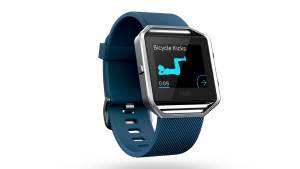Fitbit Blaze review

Last year’s Fitbit Surge confused a lot of people about where exactly it fit into the wearables market. Was it a fitness tracker? Or was it a watch?
While it looked like the latter, Fitbit wanted people to think of it as the former, which is a design ethos that has continued with the arrival of the Blaze.
 The Blaze stands apart from the Surge in its design. Inside an octagonal silver frame on a fairly standard polymer watch strap (which you can replace and upgrade for anything between $50 and $220) rests the removable Blaze device.
The Blaze stands apart from the Surge in its design. Inside an octagonal silver frame on a fairly standard polymer watch strap (which you can replace and upgrade for anything between $50 and $220) rests the removable Blaze device.
It’s a striking design, but it won’t be to everyone’s taste. The sharp edges look a little dated, like a retro Casio calculator watch, while the Blaze computer‘s bezel is disappointingly wide for such a small device.
There’s also the charger, which is incredibly frustrating — a small jewellery box enclosure snaps around the Blaze unit to charge. There’s only a USB cable in the box, so you’ll most likely need to charge it while you’re at your computer as well.
Luckily, you get about five days from the battery, so charging isn’t a daily event.
But despite its aesthetics, the Blaze is actually comfortable to wear, more so than many smartwatches. Given its relative bulk, it’s lightweight, and using it to track your sleep isn’t an issue.
The Blaze is crafted with one goal in mind: getting you fit.
 Where other smartwatches tend to overcompensate on the feature list and compromise the fitness elements, Fitbit’s Blaze restricts its smartwatch functions to just receiving call, message and calendar notifications. Everything else is geared towards fitness.
Where other smartwatches tend to overcompensate on the feature list and compromise the fitness elements, Fitbit’s Blaze restricts its smartwatch functions to just receiving call, message and calendar notifications. Everything else is geared towards fitness.
The main clock face (which can be customised from four different options via the companion app) delivers key step, heart rate and calorie information.
Swipe across the colour touchscreen and the Today menu offers a more detailed analysis of your daily progress.
The next menu is Exercise, offering a shortcut to tracking up to seven different activities, like running, walking, weights or riding your bike. Working in tandem with your phone, the Blaze can track your location for more accurate data and keep tabs on your heart rate while you work out.
But perhaps the biggest opportunity (but also, sadly, disappointment) comes from the next screen, with Fitbit’s Fitstar integration.
 For those unfamiliar, Fitstar is a mobile fitness app that Fitbit acquired last year. The Blaze offers a dedicated portal to the platform, with pre-planned workouts to help guide you through the fitness process.
For those unfamiliar, Fitstar is a mobile fitness app that Fitbit acquired last year. The Blaze offers a dedicated portal to the platform, with pre-planned workouts to help guide you through the fitness process.
The downside is that there are only three guided workouts pre-loaded on the Blaze, with no way of adding additional workouts at this point.
Fitbit has suggested more workouts will come in the future, but with an RRP of $330, it just doesn’t deliver on the opportunity.
And that’s the overall challenge of the Blaze in a nutshell. This device, more than any other Fitbit, is crying out for a more open API; an app store that could deliver a more personalised experience, be it through custom clock faces or personalised workouts.
Instead, it’s a fairly restricted device with more potential than it actually delivers.
Price: $329.95
From: Fitbit


![[Design Story] One UI Helps You Live Life Your Way – Samsung](https://loginby.com/itnews/wp-content/uploads/2025/11/1763476351_Design-Story-One-UI-Helps-You-Live-Life-Your-Way-238x178.jpg)



